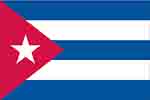
That projected dollar amount reflects a -66.8% reduction from $11.5 billion in Cuban spending on imports five years earlier in 2018.
Year over year, the overall cost of Cuba’s imported products fell by -13.5% compared to $4.4 billion during 2021.
Cuba’s Best International Trade Suppliers
Based on latest available data from 2018, over three-quarters (78.2%) of Cuban imports were bought from suppliers in Venezuela (23% of total), mainland China (13.4%), Spain (10.5%), Mexico (4.5%), Brazil (3.9%), Italy (3.4%), Vietnam (3.3%), Algeria (3.2%), Germany (3.07%), France (3.06%) and Canada (2.9%).
From a continents-based perspective, the leading share of Cuba’s imports originated from suppliers in Latin America (34.4%) excluding Mexico. Close behind were providers in Europe (30.8%) trailed by Asia (21%), North America (9.7%), Africa (3.7%), then Oceania (0.2%) led by New Zealand.
Given Cuba’s population of 11.2 million people, its estimated $3.82 billion worth of imports translates to roughly $340 in yearly product demand from every person in the Cuban collection of islands. That dollar metric lags the average $390 per capita for one year earlier during 2021.
Cuba’s Top 10 Imports
The following product groups represent the highest dollar value in Cuba’s import purchases during 2022. Also shown is the percentage share each product category represents in terms of overall imports into Cuba.
- Machinery including computers: US$418.5 million (11% of total imports)
- Meat: $409.9 million (10.7%)
- Electrical machinery, equipment: $250.4 million (6.6%)
- Cereals: $207.9 million (5.4%)
- Beverages, spirits, vinegar: $171.3 million (4.5%)
- Plastics, plastic articles: $161.9 million (4.2%)
- Dairy, eggs, honey: $157.5 million (4.1%)
- Animal/vegetable fats, oils, waxes: $150.9 million (4%)
- Vehicles: $125.8 million (3.3%)
- Articles of iron or steel: $100.5 million (2.6%)
Cuba’s top 10 imports accounted for 56.5% of the overall cost of its product purchases from other countries.
The greatest increases were the top product categories beverages, spirits and vinegar (up 30.5% from 2021), animal or vegetable fats, oils and waxes (up 73.1%), dairy, eggs and honey (up 14.3%), then meat (up 14.2%).
The severest declining categories were for Cuba’s imports of cereals (down -42%) and electrical machinery and equipment (down -37.5%).
Please note that information presented under the sections below is at the more granular 4-digit level.
Cuba’s Machinery Imports
In 2022, Cuban importers spent the most on the following 10 subcategories of machinery including computers.
- Machinery parts: US$31.1 million (down -10.6% from 2021)
- Liquid pumps and elevators: $28 million (down -6.7%)
- Taps, valves, similar appliances: $27.1 million (up 0.7%)
- Computers, optical readers: $25.5 million (down -3.4%)
- Engines (diesel): $22 million (up 51%)
- Air or vacuum pumps: $21.9 million (down -39.4%)
- Refrigerators, freezers: $21 million (down -59.3%)
- Centrifuges, filters and purifiers: $21 million (down -31.2%)
- Piston engine parts: $18.1 million (up 20.5%)
- Miscellaneous machinery: $14.3 million (down -22.3%)
Among these import subcategories, Cuban purchases of diesel engines (up 51%), piston engine parts (up 20.5%) then taps, valves and similar appliances (up 0.7%) grew from 2021 to 2022.
These amounts and the percentage gains within parenthesis clearly show where the strongest demand lies for different types of imported machinery including computers among Cuban businesses and consumers.
Cuba’s Meat Imports
In 2022, Cuban importers spent the most on the following subcategories of meat-related products.
- Poultry meat: US$357.9 million (up 6.9% from 2021)
- Swine meat: $38.4 million (up 229%)
- Frozen beef: $7.5 million (up 29.7%)
- Salted/dried/smoked meat: $4 million (up 21%)
- Sheep or goat meat: $1.2 million (up 227%)
- Fresh or chilled beef: $184,000 (down -84.7%)
- Red meat offal: $150,000 (down -32.7%)
- Pig, poultry fat: $139,000 (down -39.3%)
Among these import subcategories, Cuban purchases of swine meat (up 229%), sheep or goat meat (up 227%) then frozen beef: (up 29.7%) grew at the fastest pace from 2021 to 2022.
These amounts and the percentage gains within parenthesis clearly show where the strongest demand lies for different types of imported meat-related products among Cuban businesses and consumers.
Cuba’s Cereals Imports
In 2022, Cuban importers spent the most on the following subcategories of cereals.
- Wheat: US$102.5 million (down -33% from 2021)
- Rice: $79.6 million (down -2.2%)
- Corn: $25.5 million (down -77.1%)
- Canary seeds, miscellaneous cereals: $92,000 (down -27%)
- Oats: $76,000 (down -74.8%)
- Barley: $28,000 (up 3.7%)
Among these import subcategories, Cuban purchases of barley was the lone gainer from 2021 to 2022.
These amounts and the percentage gains within parenthesis clearly show where the strongest demand lies for different types of imported cereals among Cuban businesses and consumers.
Cuba’s Electronics Imports
In 2022, Cuban importers spent the most on the following 10 subcategories of electronics-related goods.
- Phone devices including smartphones: US$53.6 million (down -49.1% from 2021)
- Insulated wire/cable: $28.4 million (down -9.5%)
- Electric storage batteries: $17.8 million (down -22.7%)
- Electrical converters/power units: $17.1 million (down -8.6%)
- Lower-voltage switches, fuses: $16.1 million (down -9.4%)
- TV receivers/monitors/projectors: $13.9 million (down -65.4%)
- Electric water heaters, hair dryers: $13.2 million (down -65.1%)
- Electrical/optical circuit boards, panels: $12.5 million (down -44.5%)
- Solar power diodes/semi-conductors: $8.5 million (up 98.7%)
- Electric motors, generators: $8 million (down -3.8%)
Among these import subcategories, Cuban purchases of solar power diodes and semi-conductors (up 98.7%) was the lone gainer from 2021 to 2022.
These amounts and the percentage gain clearly show where the strongest demand lies for different types of imported electronics-related goods among Cuban businesses and consumers.
See also Cuba’s Top 10 Exports, China’s Top 10 Exports and Spain’s Top 10 Exports
Research Sources:
Central Intelligence Agency, The World Factbook Country Profiles. Accessed on July 4, 2023
International Monetary Fund, World Economic Outlook Database (GDP based on Purchasing Power Parity). Accessed on July 4, 2023
International Trade Centre, Trade Map. Accessed on July 4, 2023
Wikipedia, Cuba. Accessed on July 4, 2023